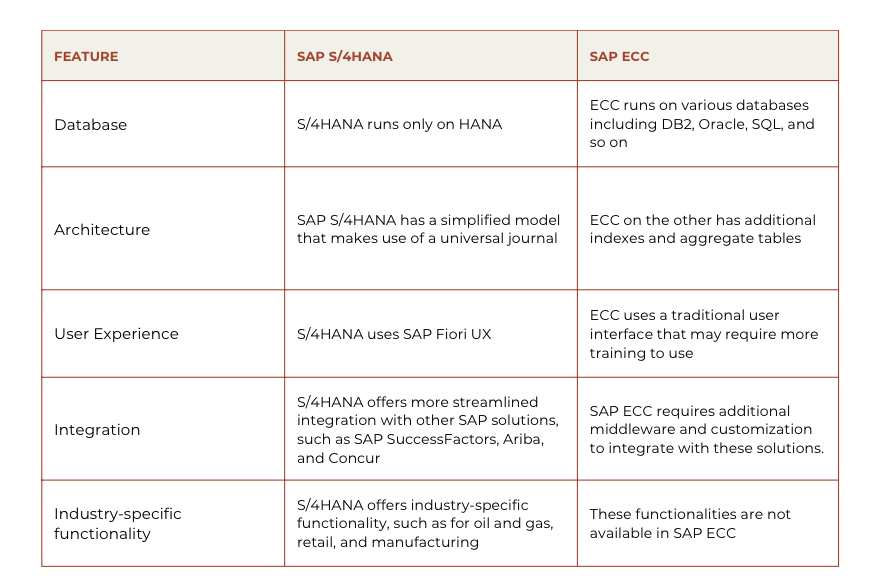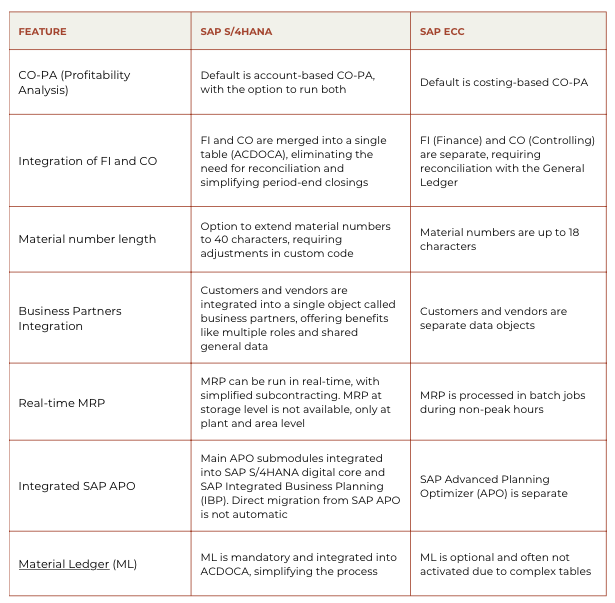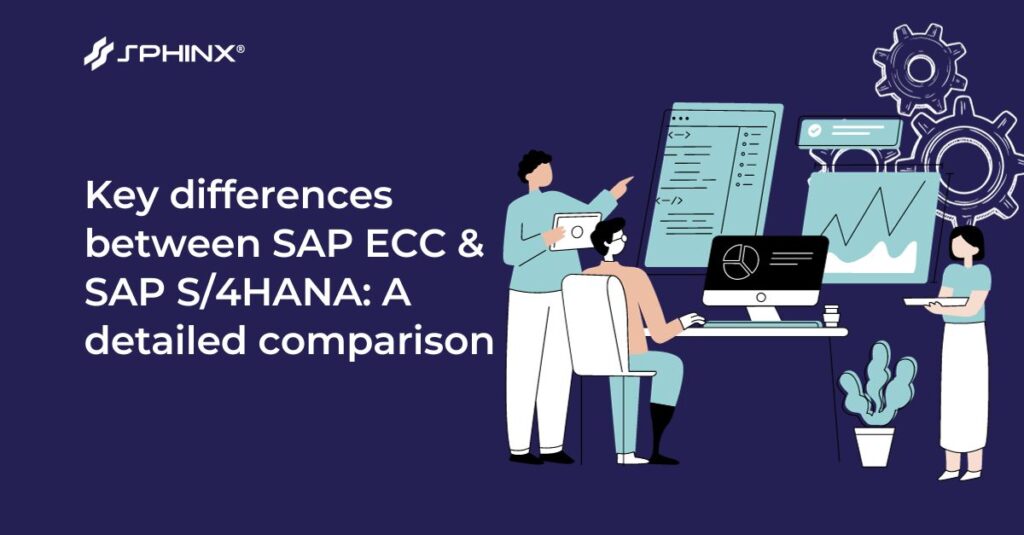SAP, founded in 1972, is a big German company with over €27 billion in sales and more than 240 million cloud users.
SAP makes ERP (Enterprise Resource Planning) software. This software improves business tasks. It helps with finance, managing stock, and sales. It also makes HR, marketing, and making new products better. SAP launched a new ERP software, SAP S/4HANA, in 2015. However, many companies still use the older version, SAP ECC. SAP plans to stop supporting ECC by 2027, so businesses need to start moving to S/4HANA. This blog will explain the main differences between the two to help you prepare for the switch.
What is SAP ECC?
SAP ECC, short for SAP ERP Central Component, is a versatile and customizable solution. It’s designed to meet the specific needs of various business areas, including finance, HR, and logistics. SAP ECC also integrates with third-party or custom applications, like business messaging tools.
While SAP ECC’s modular design offers flexibility, it also brings complexity. Changes in one component can impact others, requiring careful planning for upgrades, add-ons, or migration to SAP S/4HANA to avoid disrupting key business functions.
What is SAP S/4HANA?
SAP S/4HANA, SAP’s latest ERP software, operates both on-premise and in the cloud. It leverages AI, machine learning, and automation to boost business efficiency and speed. With SAP S/4HANA, real-time analysis of vast data is possible, along with benefits like:
- Personalized insights
- Integrated processes
- Enhanced cybersecurity
However, SAP S/4HANA works exclusively with the SAP HANA database. This might be an issue if you use a different database, like Oracle, in your current SAP ECC system. Switching to SAP S/4HANA means you’ll have to let go of unsupported add-ons.
Key differences between SAP S/4HANA and SAP ECC?
SAP S/4HANA incorporates elements from earlier SAP ERP products, including ECC. It’s been restructured to add features ECC didn’t have, such as advanced analytics and the ability to process data in real-time. But there are still some key differences:
 To be even more specific, here are some more differences that highlight the advancements SAP S/4HANA offers over SAP ECC, particularly in terms of integration, real-time capabilities, and data management:
To be even more specific, here are some more differences that highlight the advancements SAP S/4HANA offers over SAP ECC, particularly in terms of integration, real-time capabilities, and data management:

New features in SAP S/4HANA
SAP S/4HANA comes packed with a variety of new features that enhance data management. Some of the key features include:
- ACDOCA: The Universal Journal
SAP S/4HANA consolidates various data modules into one table, ACDOCA (the Universal Journal). This includes asset accounting (AA), general ledger (GL), material ledger (ML), management accounting (MA), finance (FI), and CO-PA. ACDOCA reduces many aggregate and index tables, significantly lowering the data footprint and increasing system efficiency.
- MATDOC inventory management:
SAP S/4HANA’s MATDOC is a new inventory management system that replaces over 26 tables from SAP ECC. Material documents are now stored in MATDOC, not in MKPF or MSEG tables, reducing redundancy and enhancing stock reporting efficiency.
- SAP HANA database:
As we discussed above, SAP S/4HANA exclusively runs on the SAP HANA database. Thanks to SAP HANA Cloud, it’s faster and more efficient than SAP ECC. Key reasons include data reading from main memory (not hard disk), column-based table structure for efficient queries, parallel column processing, and the absence of aggregate, index, or history tables. SAP S/4HANA merges online transactional processing (OLTP) and online analytical processing (OLAP) tables, eliminating the need for reconciliation.
- Advanced ATP:
In SAP ECC, the available-to-promise (ATP) feature allows you to check product availability, allocations, and backorders. However, SAP S/4HANA enhances this with its advanced ATP (aATP). aATP brings automation into play for several functions, such as:
- Releasing items for delivery;
- Checking stock availability in alternative plants;
- Performing mass availability checks.
- Global trade services:
With SAP S/4HANA includes global trade services (GTS), which take over the foreign trade functions from SAP ECC. SAP GTS enhances efficiency by automating tasks like embargo checking, license checks, and import/export declarations, which were manual in SAP ECC.
- FSCM Credit management:
SAP ECC’s credit management system was known as FI-AR-CR. In SAP S/4HANA, it’s part of financial supply chain management (FSCM). FSCM Credit Management (FSCM-CR) uses automated workflows for credit limit approval and risk scoring, reducing manual effort. Additionally, its distributed architecture allows direct interfacing with external credit agencies.
- Extended Warehouse Management:
Warehouse management in SAP ECC is managed by the Warehouse Management (WM) module. SAP S/4HANA replaces this with the extended warehouse management (EWM) module. SAP EWM simplifies complex warehouse processes such as labor management and goods distribution.
- Revenue Accounting and Reporting (RAR):
In SAP S/4HANA, the Revenue Accounting and Reporting (RAR) module takes the place of SAP ECC’s SD Revenue Recognition module. RAR, an add-on, is aligned with the new five-step revenue recognition model of International Financial Reporting Standard 15 (IFRS 15). It introduces improved contract management capabilities for IFRS 15 compliance and simplifies revenue recognition processes.
- SAP Fiori user interface:
SAP S/4HANA brings in the SAP Fiori user interface, offering a uniform, intuitive, and integrated user experience. SAP Fiori enables quicker and more accurate task completion, enhancing onboarding and training processes and overall user satisfaction. It also allows for the creation of custom enterprise applications with consistent performance across various devices.
Advantages of Upgrading to SAP S/4HANA
In a 2021 survey conducted by Redhat.com, 72% of businesses identified improved efficiency as the primary benefit of SAP S/4HANA, followed by increased satisfaction (61%), better integration with other SAP products (33%), and minimized downtime during migration (33%). Other advantages of transitioning to SAP S/4HANA include:
- Enhanced integration with other SAP products.
- Reduced costs, including lower operational and ownership expenses.
- A smaller database footprint, thanks to simplified data models.
- Increased productivity and performance through automated processes.
- Quicker and smarter decision-making capabilities.
- A boost in overall profits.
Why delay the switch?
The transition from SAP ECC to SAP S/4HANA can seem overwhelming due to its many differences. However, there’s a compelling argument for making the move to SAP S/4HANA, especially considering the 2027 maintenance cut-off for SAP ECC.
In conclusion, the transition to SAP S/4HANA presents a strategic opportunity for businesses to upgrade their ERP systems and embrace a more efficient, AI-driven future. While the change might appear challenging, the long-term benefits of improved efficiency, cost savings, and enhanced customer experiences are undeniable.
For companies looking to make this switch, choosing the right partner is crucial. In this regard, partnering with a knowledgeable and experienced company like 스핑크스 can make all the difference. Their expertise in facilitating smooth transitions to SAP S/4HANA ensures that businesses can navigate this change with confidence and ease, positioning themselves for success in an increasingly digital world.




CEO - Son Le
기타 블로그
블로그
AI Driving Innovation: Key Impacts, Challenges and Market Trends
Artificial Intelligence is rapidly moving from a supportive capability to a central engine of innovation across modern enterprises. Its advancements in automation, generative modeling and real time analytics are redefining how organizations operate, scale and deliver value. As AI becomes embedded into products, workflows and strategic decisions, it is reshaping...
자세히 보기블로그
Top 10 Countries for IT Outsourcing in 2026
IT outsourcing is becoming an increasingly popular strategy as businesses worldwide seek to accelerate digital transformation, reduce operational costs, and access specialized tech talent. With the rapid growth of cloud computing, AI, and software development demands, more companies are turning to global partners to stay competitive and scale efficiently. In...
자세히 보기블로그
Transform Your Business with SAP Consulting Support
In today’s digital-first landscape, enterprise systems must evolve continuously to keep up with rising customer expectations, data complexity, and the demand for operational excellence. SAP plays a central role in this transformation, offering intelligent, integrated solutions that help organizations modernize their operations and drive long-term growth. However, SAP only delivers...
자세히 보기기타 블로그
서비스
IoT 개발
SphinX는 최첨단 IoT 개발 서비스를 제공하여 디바이스를 원활하게 연결하고 혁신적인 솔루션을 제공합니다.
테마서비스
블록체인 개발
우리는 신뢰할 수 있고 안전한 블록체인 기술을 처음부터 설계하는 데 매우 능숙하며, ...
테마서비스
ERP 및 CRM 개발
필요한 ERP & CRM 개발 서비스! 비즈니스 프로세스 간소화 및 조직 효율성 향상....
테마기타 블로그
서비스
IoT 개발
SphinX는 최첨단 IoT 개발 서비스를 제공하여 디바이스를 원활하게 연결하고 혁신적인 솔루션을 제공합니다.
테마서비스
블록체인 개발
우리는 신뢰할 수 있고 안전한 블록체인 기술을 처음부터 설계하는 데 매우 능숙하며, ...
테마서비스
ERP 및 CRM 개발
필요한 ERP & CRM 개발 서비스! 비즈니스 프로세스 간소화 및 조직 효율성 향상....
테마